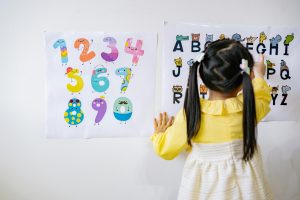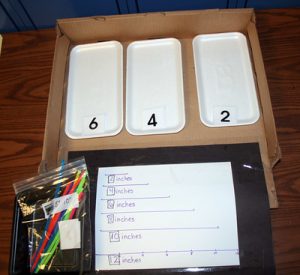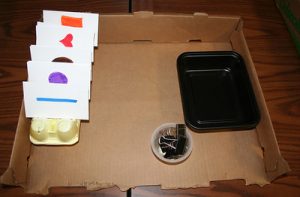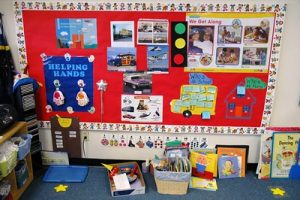Strategies for Guiding Children’s Behavior
Learning Objectives
After reading this chapter, you will be able to:
- Design your classroom to be inclusive for all students.
- Recognize children’s various abilities in your classroom.
Classroom Design

Physical Environment
A positive environment for learning and development will help reduce mistaken behaviors. When a child displays mistaken behavior, it is important to consider how frequently the behavior occurs, and what it may be in response to, in which settings it occurs and how extreme it is.
There may be times when a child displays mistaken behavior that is isolated or infrequent. In some situations, the service may need to increase the educator to child ratios to meet the needs of children with mistaken behavior. The key to understanding children’s behavior is to aim to identify the reasons for the behavior.
For a child under preschool age, assessments of their developmental needs, interests, experiences, progress against the learning outcomes and participation in the educational program; and for a child over preschool age, evaluations of the child’s wellbeing, development and learning can be used to inform behavior management strategies that may assist to minimize mistaken behaviors at the education and care service.
For children over preschool age the aim is to empower them to make favorable choices, develop positive and respectful relationships and to reflect and act upon what is fair and equitable. Educators can assist and guide older children’s capacity to interact with others in respectful and cooperative ways and to develop their independence and ability at self-regulation.
It is important to ensure that children’s behavior is observed and documented carefully and sensitively by educators and a holistic view of the child developed in the context of an understanding of the purpose of the behavior.
Observations need to be recorded and information collated so that an informed decision can be made about whether individual behavior guidance strategies are required or whether the behavior can be addressed through the daily behavior guidance practices of the service.
Treatment and Education of Autistic and related Communication-handicapped CHildren (TEACCH) Tasks


TEACCH (Treatment and Education of Autistic and related Communication Handicapped Children) uses structure, predictability, and visual supports to create a positive learning environment. TEACCH tasks can be effectively used to manage behaviors by providing structure and predictability. The student works from left to right to complete a series of tasks independently at a workstation. The student should be provided with tasks that can be done independently until the tasks are completed quickly without support. The TEACCH tasks should break down complex tasks into smaller, more manageable steps. Present these steps visually using picture cards or checklists. This reduces frustration and increases independence. Designate clear containers with pictures representing the materials needed for each task. This helps children know what’s expected and where to find things, promoting independence and reducing confusion. The students should be acknowledged and praised for completing tasks and/or following directions. This reinforces positive behavior and motivates them to continue.
Although, TEACCH tasks have been designed to help with with autism, it can be beneficial any student that needs to take a break from working in small or large groups. Allowing the student to work independently to complete TEACCH tasks can help boost their self-confidence and autonomy. TEACCH tasks can be adapted to each child’s specific needs and learning styles. By implementing TEACCH tasks strategically, you can create a structured and predictable environment that promotes positive behavior, reduces frustration, and fosters independence for all learners.
Visual Cues and Social Stories

Visual cues help ALL children to understand their daily routines and schedules. They can be used to assist with building language when used to label areas of the classroom. visual cues and social stories can be powerful tools for managing behaviors. Visual cues, like picture schedules or color-coded areas, provide clear and immediate information to young children who are still developing their language skills. A picture schedule with images depicting playtime, snack time, and circle time can help children understand the flow of the day and anticipate transitions, which can be a common trigger for challenging behaviors. Similarly, social stories can be used to model appropriate behavior in different scenarios. A story about sharing toys or calming down when frustrated can help children learn positive coping mechanisms and understand the emotional impact of their actions on others. By using visuals and social stories in a proactive way, educators can create a more predictable and supportive environment that reduces confusion and helps children develop the skills they need to manage their own behavior.
Social and Emotional Environment
Applying positive guidance involves very intentional teaching to redirect and manage behaviors in the classroom. This involves reframing our language and attitudes, as well as understanding that behavior is a form of communication. Deciphering what the student is communicating by their actions takes patience and a great deal of understanding developmentally appropriate practice for the age group you are working with and forming a trusting relationship. By combining positive guidance with trauma-informed practices, we, the early childhood educators, will foster resilience, emotional well-being, and a love of learning for all children. Here are some strategies to consider for providing a welcoming and safe social and emotional environment:
- Focus on what you want: Instead of saying “Don’t run,” use positive language like “Use walking feet inside.” If there is a student that uses a mobility device such as a wheelchair or walker, use the language that will address the entire such as, “Please use your slow moving bodies. in the classroom”
- Provide choices: Offer age-appropriate choices to give children a sense of control, like “Do you want to wear the red or blue shirt?”
- Redirection: If a child engages in unwanted behavior, gently redirect them to a more appropriate activity.
- Positive reinforcement: Acknowledge and praise good behavior to encourage repetition.
- Building trust: Create warm and responsive relationships with children through genuine interest and active listening.
- Predictability and routines: Maintain consistent routines and schedules to provide a sense of security and reduce anxiety.
- Understanding triggers: Be aware of potential triggers for past traumas (loud noises, separation) and offer alternative calming strategies.
- Self-regulation tools: Provide calming areas with soft materials, deep breathing exercises, or sensory activities to help children manage emotions.
- Collaboration: Work with families and other professionals to understand a child’s background and provide consistent support.
